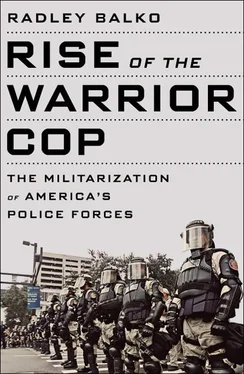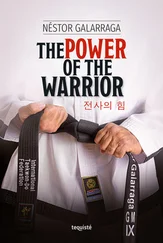Wilson’s tenure as MPD chief ran nearly concurrently with Nixon’s tenure as president. (Wilson took office five months after Nixon and left a month after Nixon resigned.) Under Jerry Wilson, violent crime in DC dropped 25 percent and property crime dropped 28 percent. Under Nixon, violent crime in the country as a whole went up 40 percent and property crime rose 24 percent. 35There are obviously countless variables at work in that sort of comparison. And even under Nixon, crime was still primarily a local issue. But while Nixon may not have had a direct effect on local crime policy, he did set the tone. State legislatures across the country passed get-tough-on-crime bills that gave cops more power, more authority, and more heavy-duty equipment. The country as a whole moved toward Nixon’s get-tough policies, and crime continued to soar. Washington, DC, moved away from the aggressive approach over the same period, and its crime rate dropped.
At the time, Wilson credited the DC crime drop to the one thousand additional police officers Nixon had given him funding to hire, the methadone program, and seemingly mundane changes like improved street lighting. Others credited some of the less controversial parts of the DC crime bill pushed by Don Santarelli, like reorganizing the city’s courts. But much of the credit undoubtedly belonged to Wilson himself and his less confrontational, community-oriented approach to policing.
Hard-line Nixon officials didn’t know quite what to make of the fact that their model city had passed on the two most controversial, high-profile provisions in the DC crime bill, and crime had gone down anyway. So they spun. Mitchell said that Wilson’s work in DC was proof that the press had overhyped the dangers of preventive detention and the no-knock raid.
Wilson’s reluctance to utilize either law didn’t hurt his reputation with the administration in the least. “They didn’t really pressure us to use the no-knock raid at all,” Wilson says. “We told them we didn’t need it, and from what I can remember, they never brought it up again.” 36Nixon and Mitchell were more than happy to tout and take credit for the results in DC. However, they wouldn’t go out of their way to publicize just which parts of the crime bill were being used and which ones weren’t. 37

IN 1971 TWO POSITIONS OPENED ON THE US SUPREME COURT with the retirements of Justice Hugo Black and Justice John Harlan. Nixon now had an opportunity to move the Court significantly to the right, especially with respect to how it would handle the law-and-order issues he’d run on. He had already made some progress with his first two nominations, replacing the much-loathed Earl Warren with “strict constructionist” Warren Burger in 1969, and nominating Harry Blackmun after Lyndon Johnson’s crony Abe Fortas stepped down. Now he had two more picks—a historic opportunity to remake the Court and, perhaps more importantly in Nixon’s world, to “stick it to the left,” as White House chief of staff H. R. Haldeman would put it in his diary. 38
Nixon had run into problems, however, with his last appointment. His first nomination to replace Fortas, Clement Haynsworth, became the first Supreme Court nominee to be rejected by the Senate in nearly forty years. The Senate rejected his next nominee too—G. Harrold Carswell—before finally confirming Blackmun.
This time the White House circulated a preliminary list of names, which met with derision in the media and parts of the Senate. Nixon then had to withdraw the first two nominees he announced after they were deemed unqualified by the American Bar Association. Nixon finally turned to Louis Powell, a Virginia lawyer who had previously served as president of the ABA. Powell was quickly confirmed.
Nixon’s nomination for the other position was something of a surprise. William Rehnquist was head of the Justice Department’s Office of Legal Counsel (OLC), where his job was to write legal opinions when the administration requested them. (A critic might argue that the office exists to give the executive branch a legal argument justifying it to do just about anything it wants.) Nixon often mistakenly called him “Renchberg.”
From his position in the OLC, Rehnquist signed off on all of the controversial provisions in Nixon’s various crime bills, including preventive detention, expansive wiretapping powers, and the no-knock raid. 39He was as hawkish on crime as anyone in the administration. John Mitchell once said that Rehnquist was the “only lawyer I know who would willingly defend the Sheriff of Nottingham.”
Rehnquist had a bumpier road to confirmation than Powell. But after some often contentious hearings and debate—including some aggressive questioning from Sen. Sam Ervin about Rehnquist’s time at the OLC—he was confirmed in December 1971 by a vote of 68–26. 40
The man who had written the legal justifications for Nixon’s crime policy now had a seat on the US Supreme Court.

BY THE SUMMER OF 1971, NINETEEN STATES HAD ADOPTED Nixon’s model antidrug legislation. 41His brute force approach to attacking the drug supply had begun to filter down to local police agencies. But Nixon was stewing over the fact that despite their success in making crime an issue and pushing through some of the toughest crime bills the country had ever seen, they’d yet to reap much political benefit from the effort. The evidence lay in the modest results of the 1970 midterms. “We still haven’t gotten through the strong position on law and order despite our leadership in this field, all of the public relations devices we use to get it across, and my hitting it hard on the campaign,” Nixon wrote in a December 1, 1970, memo to his chief of staff, H. R. Haldeman. 42An internal poll taken a few months later confirmed his analysis—the public feared crime but was still largely unaware of anything Nixon was doing about it. 43
The White House needed something tangible to tout to the public. If they couldn’t use actual crime data to show their initiatives were working, perhaps they could just create their own impressive statistics by generating lots of arrests and convictions at the federal level. The journalist Edward Jay Epstein writes, “[Nixon] reminded Ehrlichman and Krogh that there was only one area in which the federal police could produce such results on demand—and that was narcotics.” 44
But there remained the question of how to do it. While the federal narcotics enforcement agency, BNDD, had been expanded from four hundred officers in 1969 to two thousand by 1971, Nixon and Mitchell had been persuaded early in the administration to focus the agency’s energy on targeting high-level traffickers, at home and overseas. Its mission was to drain the drug supply, which meant long, complicated investigations that in theory would result in high- quality arrests, but not in a high quantity of them. 45Krogh had asked BNDD director John Ingersoll to reverse course and devote resources to making easy, high-profile arrests of low-level offenders that the administration could use for PR purposes. Ingersoll refused, arguing that those sorts of arrests might have made for good politics, but they did little to reduce crime or addiction. The BNDD was just one among several federal bureaucracies that had been pushing back on Nixon’s increasingly aggressive antidrug policies. He was also getting frustrated by the lack of cooperation from the Treasury Department and the Department of Health, Education, and Welfare.
So the White House crime team came up with a plan. They would launch an all-out PR offensive to scare the hell out of the public about crime, and to tie crime to heroin. Once voters were good and terrified, they would push for reorganization to consolidate drug policy and enforcement power within the White House. Krogh put together a quick-hitting but multifaceted strategy that included planting media scare stories about heroin, publicly recalling ambassadors to embarrass heroin-producing countries like Thailand and Turkey, and holding high-level (but entirely staged) strategy sessions that they’d invite the media to attend. The plan culminated with a planned speech from Nixon that would forge new frontiers in fearmongering. An aide to Krogh told the journalist Epstein years later, “If we hyped the drug problem into a national crisis, we knew that Congress would give us anything we asked for.” 46
Читать дальше













